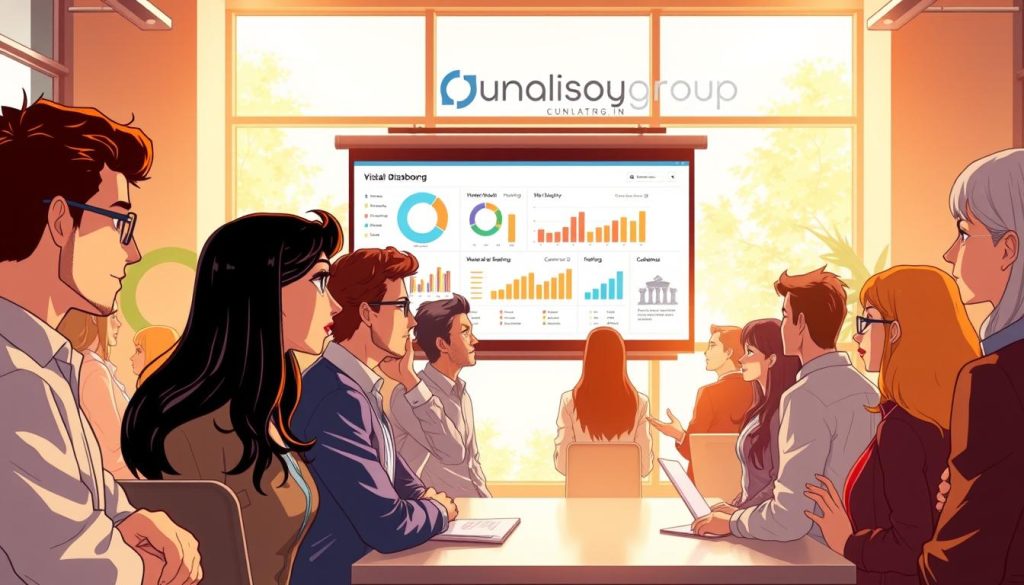Over 1.1 billion jobs will be transformed in the next decade. That scale reshapes the job market and raises the stakes for every independent professional in France.
We offer a clear path to steady growth and income protection in times of automation, climate action, and rapid digitalization. Our approach mixes practical learning with strategic planning so you can keep delivering value to clients while you learn.
Timing matters: targeted learning reduces transition risk and opens concrete opportunities. This guide shows which skills to prioritize, which organizations and tools speed progress, and how to fit education into busy work calendars.
Outcome-focused: expect stronger client communication, higher-value projects, and more resilience to market shifts. We blend trusted insights with hands-on practices to help you convert time into career success.
Table of Contents
Key Takeaways
- Over a billion roles will change; act now to protect income and options.
- Targeted learning yields predictable growth without stopping billable work.
- Choose organizations and tools that offer practical, work-friendly education.
- Focus on transferable skills to stay valuable to companies and clients.
- Small, sequenced milestones deliver measurable success over time.
The future job market: why skill development matters now
As markets evolve, timely adjustments to your capabilities become a practical necessity. The World Economic Forum projects that over a billion people will need reskilling by 2030, and more than 1.1 billion jobs face transformation from automation, climate action, digitalization, and demographic shifts.
Urgency indicators
Move early to reduce competition: when a large share of the workforce must change, early adopters capture premium roles and better rates in the job market.
Many firms already flag workforce constraints—23% globally, and in parts of Africa and Latin America this reaches 40–60%.
Megatrends reshaping work
Automation and digital products rebuild business systems around data. Climate action creates demand for green services and compliance tasks. An aging labor force changes how teams are staffed and where remote work fits.
- Track demand signals: client briefs, sector reports, and public tenders reveal near-term opportunities.
- Simple analysis routine: run quarterly scans of credible education and labor information to rank learning priorities.
- Address barriers: foundational literacy and access gaps can be closed with short-form education and flexible training that fits your schedule.
Practical start: run a four-week sprint to align your offerings to current market demands, then plan longer-term growth with partner organizations and targeted learning paths.
What is skill development? Definitions, modes, and core skill types
Understanding how people grow their capabilities helps you plan profitable shifts in what you offer clients. In plain terms, skill development is a continuous process of acquiring, enhancing, or refining abilities, knowledge, and competencies that map to market demand.
Modes for career agility
Use three tactical routes: upskilling to deepen a niche, cross-skilling to widen your offers, and reskilling to pivot into a new role. Each mode has different time, cost, and billable-impact trade-offs.
Core types to prioritise
Foundational cognitive areas—literacy, numeracy, problem-solving—speed later learning and raise baseline value.
Socio-emotional abilities such as leadership and communication improve client discovery, negotiation, and delivery on complex projects.
Specialised and technical skills, including domain tools and entrepreneurship, directly boost your hourly rate.
| Mode | Purpose | When to choose |
|---|---|---|
| Upskilling | Deepen existing strength | Higher rates in current niche |
| Cross-skilling | Broaden offer set | Complementary services for clients |
| Reskilling | Shift to new job family | Market signals show growth |
Practical routine: weekly drills and short projects turn learning into reliable delivery. Paste a compact taxonomy into your CV so buyer searches match your experiences and propositions.
Global and EU trends driving demand for new skills
Across Europe and beyond, megatrends are reorganizing demand — and budgets — toward green and digital work.
Green-digital transition: the shift creates openings in energy efficiency, circular economy services, data offerings, and compliance. These areas boost employability and productivity and point to clear priorities for what to learn first.

Green-digital transition: workforce opportunities and structural transformation
The European Year of Skills and cohesion funds steer investment toward digital and green education. That funding signals client budgets and upcoming procurement windows.
Aging and shrinking labor force: implications for productivity and inclusion
An older, smaller workforce raises demand for independent professionals who can lift productivity without adding headcount. This increases market space for targeted freelance offers.
EU labor market insights: ESDE 2024 and priorities
ESDE 2024 highlights expanding sectors and inclusion priorities. Regional differences matter; tailor prospecting to where investments and calls for projects appear.
« Policy and funding are now matching real-world demands — notice where procurement follows the money. »
- Systems implication: credentials portability, hybrid learning, and recognition of prior learning shorten time-to-value for any new skill development.
- Address gaps in foundational literacy and information hygiene; these are competitive differentiators for data-heavy work.
- Adopt a simple quarterly scanning habit of EU reports and national calls to catch early signals and align offers with initiatives and demand.
skill development
Treat continuous capability building as the operating system that keeps your freelance practice resilient and growth-ready.
Set clear goals tied to client outcomes and revenue. Choose a practical approach: short weekly practice, monthly projects, and a quarterly review. This cadence balances delivery and learning while protecting your growth trajectory.
Use a simple success scorecard that mixes education milestones with client metrics — proposal hit rates, project cycle time, and upsell conversions. A needs-first review of your pipeline tells you what to learn next.
Follow a compact practice loop: learn, apply on a small task, collect feedback, and iterate. Repeat this weekly and watch compound growth in three to six months.
- Templates: backlog, goal tracker, and a proposal language checklist to signal new capabilities.
- Accountability: peer reviews for rapid troubleshooting and steady progress.
This is a protective strategy: organized learning and clear measurement help people keep earnings steady and capture new opportunities fast.
Closing the skills gap: key challenges and opportunities
Tackling uneven participation and weak assurance will unlock faster returns for people and organizations.
Access and completion remain core barriers. Around 750 million adults lack basic literacy, and completion rates vary. Returns to education differ by program: vocational graduates in Brazil earn about 10% more than peers from general secondary tracks. We help you choose options with proven placement and wage rates so your time pays back.
Adaptability matters. Fast-changing technical and transversal demands require modular approaches you can apply without pausing client work. Micro‑learning and short projects close gaps quickly.
Quality and relevance are uneven. Many TVET systems lack robust assurance and employer engagement. Look for programs with employer partnerships, clear outcomes, and assessment transparency.
Efficiency and financing shape availability. Most countries invest under 0.5% of GDP in adult lifelong learning, limiting scale. That underinvestment creates market openings for independent experts who deliver measurable outcomes.
Practical checklist:
- Prioritize programs with employer links and clear placement data.
- Use micro‑paths for literacy and basic digital tools.
- Mix free resources, grants, and client-funded training to finance learning.
| Challenge | Typical impact | Fast response | Where to look |
|---|---|---|---|
| Low access | Missed opportunities | Short modular courses | Local NGOs, grants |
| Poor completion | Weak outcomes | Project-based practice | Employer-run bootcamps |
| Quality gaps | Low employer trust | Demand employer engagement | Accredited TVET, industry pilots |
| Financing limits | Slow scale | Client-funded upskilling | Public funds, partnerships |
Proven strategies for people and organizations to develop in-demand skills
A lean program of analysis, coaching, and applied practice makes learning work for busy freelancers. We focus on fast, measurable steps that align short- and long-term demands with what you already offer clients.
Identify priorities with a quick analysis
Run a two-hour Training Needs Analysis to map gaps and market signals. Use a simple checklist: current offers, client requests, and near-term market demands.
Plan with Individual Development Plans and matrices
Create an IDP with clear goals, milestones, and review dates. Maintain a compact competency matrix to track progress and to set pricing and opportunity targeting.
Accelerate growth with coaching and feedback
Set up lightweight mentorship and use 360-degree feedback to improve communication and leadership on projects. Short coaching sprints sharpen delivery and client outcomes.
Build versatility through cross-training and rotation
Rotate roles across sales, delivery, and ops to broaden capabilities. Cross-training in adjacent technical skills compounds value and opens retainer opportunities.
| Measure | Action | Frequency |
|---|---|---|
| Needs | Two-hour analysis checklist | Quarterly |
| Plan | IDP with milestones | Monthly review |
| Practice | Weekly applied tasks to client work | Weekly |
| Accelerate | External expert sprints | As needed |
Quick tip: combine self-directed learning with a live project to lock gains. Bring in external experts for short, focused sprints when you need rapid mastery.
Tools and innovation: making learning continuous, personalized, and scalable
A compact toolset lets independents balance delivery while they learn, without risking deadlines. Use software and methods that make capacity visible and keep client work protected.
Resource management and forecasting
Resource management software provides forecasting, capacity planning, and dashboards. These features prevent overbooking and protect delivery when you schedule training.
Practical outputs: live competency matrices, utilisation views, and simple reports that inform the next learning step.
Immersive learning and XR labs
ActiVaR’s XR work shows immersive training raises engagement and lowers practical risks. Virtual campuses and labs help you practise safety-critical tasks in a controlled setting.
Digital initiatives and guidance
DE4A guidebooks offer structured frameworks for higher education and TVET. Even outside Africa, their methods help you plan short training paths and measurable outcomes.
- Choose tools for information integrity, interoperability, and total cost of ownership.
- Capture knowledge artifacts so learning turns into reusable assets.
- Start with a small pilot project: a micro-simulation that measures speed to competence.
Regional focus: France and the European Union’s workforce skills initiatives
Local networks and EU programmes open concrete routes for independents to work with young talent, SMEs, and public projects.
France: EPIDE and Avenir’ Pro offer pathways that improve youth employability and transitions. These organizations run training and placement projects where independents can mentor, subcontract, or deliver short courses. Partnering with them gives you access to motivated candidates and funded work opportunities.
EU ecosystem: Good practices such as PLAY YOUR SKILLS, Lisbon City of Learning, RAISE Youth, INTERCEPT (green career routes), and Go Remote (remote job matching) create practical areas to expand your offers. They provide tools for documenting education outcomes and city‑level learning systems that help you find clients beyond local markets.
Policy and guidance: Use recent EU publications — ESDE 2024, the European Year of Skills cohesion funds, the European Pillar of Social Rights Action Plan, EU Youth Strategy, and The Union of Skills — to anticipate funding windows and align your project proposals with priority areas.
| Program | Primary focus | How independents can engage |
|---|---|---|
| EPIDE | Youth employability and social integration | Mentoring, workshops, subcontracted training |
| Avenir’ Pro | Transitions to work for young people | Short project delivery, placement support |
| INTERCEPT | Green career pathways for SMEs | Consultancy, green audits, tailored course offers |
| Go Remote | Remote job matching and digital opportunities | Remote coaching, compliance advice, recruitment support |
- Practical checklist: confirm documentation, evidence of outcomes, and basic compliance when bidding for education projects.
- Try two micro-collaboration models: a four-week subcontracted training sprint and a mentoring match tied to a placement outcome.
- Align offers with youth and inclusion initiatives to close gaps and add social impact to your portfolio.
Measuring impact: outcomes, equity, and ROI of training and development
To judge whether training truly pays, track short-term signals and long-term outcomes that matter to clients and funders.

KPIs to track
Focus on a concise set: utilization, delivery performance, placement or client acquisition rates, engagement, and retention. Use simple formulas to make results repeatable.
| KPI | Metric | How to measure |
|---|---|---|
| Utilization | % billable time | Timesheets or billing reports |
| Placement | formal hires or contracts | Follow-up surveys at 3 months |
| Engagement | completion & feedback | Post-project surveys |
Closing data gaps & benchmarking
Use proven rubrics such as STEP and SABER to benchmark workforce skills. These tools help you compare outcomes and set quarterly goals.
Equity lens
Target offers for women, disadvantaged groups, and rural youth. This expands opportunities, attracts funding, and strengthens your impact narrative.
- Communication cadences: short client check-ins after each project to collect evidence.
- Lightweight system: dashboards or shared sheets to track tool usage, training time, and rates.
Conclusion
Close the loop: translate what you learn into small projects that prove value to clients. Start with one focused initiative this week and plan a quarterly project to validate progress.
Prioritize practical education and the few highest-impact skills that match market demands. Spot gaps with quick audits, then use repeated practice and short projects to close them fast.
Document your knowledge and leadership moves so companies see measurable outcomes. Calendar learning sessions to protect time and keep client delivery steady.
Use French and EU programs to boost credibility and access opportunities. Keep a simple scorecard: track goals, results, and adjustments for steady growth and long-term success.
FAQ
What does "Master New Skills" mean for an independent professional?
It means building the mix of technical knowledge, transferable abilities, and digital literacy that lets you remain competitive and secure work. For independents, this includes targeted training, portfolio projects, and clear evidence of outcomes so clients can trust your expertise.
Why is skill development urgent in today’s job market?
Rapid automation, climate transition, digitalization, and demographic change are reshaping roles. International estimates point to large reskilling needs by 2030, so acting now preserves employability and opens new opportunities in growing areas like green tech and digital services.
What are the main modes of learning professionals should consider?
Choose among upskilling to deepen current strengths, cross-skilling to broaden into adjacent functions, and reskilling to move into new occupations. Combine formal courses, micro-credentials, on-the-job projects, and mentoring for best results.
Which core competencies should I prioritize?
Prioritize foundational abilities such as literacy and numeracy, higher-order reasoning like problem-solving and analysis, socio-emotional skills like communication and leadership, and relevant technical expertise tied to your sector.
How important are digital skills across professions?
Digital competencies are a cross-cutting requirement: from safe information use to creating digital products. Even nontechnical roles benefit from basic data literacy, cybersecurity awareness, and collaboration tools knowledge.
How does the green-digital transition affect independent workers?
It creates demand for new services and products—energy efficiency consulting, green supply-chain expertise, and digital transformation support. Independents who align offerings with sustainability and digital trends gain competitive advantage.
What implications do aging populations have for the labor market?
A shrinking workforce increases demand for productivity-enhancing roles, flexible work arrangements, and inclusion measures. This opens opportunities in health tech, remote services, and automation-support roles that independents can serve.
How can I close gaps between what employers need and what I offer?
Start with a training needs analysis to identify short- and long-term demand. Then create a personalized plan, seek mentorship, engage in cross-training, and document outcomes with competency matrices or portfolios to prove relevance.
What barriers limit access and completion of training?
Key obstacles include time, cost, limited local offerings, and insufficient employer recognition. Solutions include microlearning, subsidized programs, remote modules, and partnerships with industry to ensure practical relevance.
How should organizations measure learning impact and ROI?
Track KPIs such as utilization, performance improvements, placement rates, engagement, and retention. Combine qualitative feedback with hard metrics to evaluate equity and long-term returns on learning investments.
What governance and financing challenges affect lifelong learning?
Common issues are fragmented funding, weak data systems, and limited employer collaboration. Better governance uses workforce data for planning, public–private funding blends, and clear accountability for training quality.
How can independents leverage tools and innovation to learn at scale?
Use resource management and forecasting platforms for skills visibility, explore immersive XR labs for hands-on practice, and tap digital initiatives that offer modular courses and micro-credentials suited to flexible schedules.
Are there specific European programs that support workforce transitions?
Yes. The European Union publishes guidance and funds initiatives aimed at NEETs, green careers, and upskilling. National programs in France—such as those supporting youth employability—also offer pathways for practical training and placements.
How can I ensure training is high quality and relevant?
Prefer programs with employer engagement, clear competency frameworks, practical projects, and assessment standards. Technical and vocational education and training (TVET) that aligns with industry needs delivers stronger outcomes.
What role do mentorship and feedback play in professional growth?
Mentorship, coaching, and 360-degree feedback accelerate learning by providing personalized guidance, real-time correction, and career advice. They bridge theory and practice more effectively than solitary study.
How do I make a credible case to clients about my new capabilities?
Build a portfolio of applied work, gather testimonials, earn recognized micro-credentials, and present measurable outcomes—such as productivity gains or successful project metrics—to demonstrate value.
How can we address equity in access to opportunities?
Design programs with targeted outreach for women, disadvantaged groups, and rural youth; offer flexible formats; subsidize costs; and measure participation and outcomes to ensure fair access and impact.





